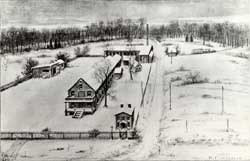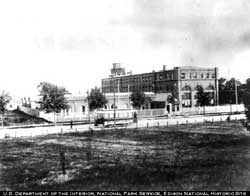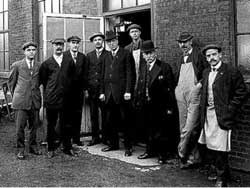
NPS Photo Moves to West Orange at the age of 40, the future still looked bright for Thomas Alva Edison. He also had hundreds of patented inventions. For almost ten years already, he had toiled away at his direct current electric power system. He and his "muckers" had designed light bulbs and dynamos at his small lab in Menlo Park, New Jersey. Lower Manhattan already glowed with his incandescent lights. Newspapers called him the "Wizard of Menlo Park." He had also bounced back from the death of his first wife. The year before he had married the 20-year-old Mina Miller. Just before their wedding in February 1886 he had bought her Glenmont, a 13-1/2 acre estate with a three-story mansion, located within the private community of Llewellyn Park in West Orange, New Jersey. Edison had never lived like this before. Most men might be happy with love, wealth and comfort. But Edison needed more. He needed to use his genius. The Wizard had outgrown the laboratory that had made him famous. He needed a lab as big as his dreams. So he built one down the hill. 
NPS Photo In 1887, Edison hired architect Henry Hudson Holly to design his largest laboratory ever. (Holly had also designed Edison's Glenmont estate.) As many as 200 men worked in this six building lab complex. Half of the inventor's 1,093 patents came to light here: his work with motion pictures, most of his improvements to the phonograph, and experiments with cement, alkaline batteries and rubber substitutes. When it was built, the West Orange lab complex was probably one of the largest in the world. But the factory buildings surrounding it were much larger. Here Edison could not only make new inventions, but manufacture them to sell to the world. The West Orange lab and factories hired people from all over the United States and Europe. Ignatius Goldstein came from Poland to work as a chemist in Building 2. A. Theo E. Wangemann, one of several German "muckers" with university training, helped build a recording studio on the third floor of Building 5. His young assistant, Walter Miller, came from neighboring East Orange. 
NPS Photo "Muckers" and the Invention Process As "chief mucker," Edison might think of new ways to improve an invention, such as his phonograph. Then he picked teams of laboratory workers, or "muckers," to build it and test it. Muckers could work faster in teams than as individuals. By putting their heads together, they also might discover more creative solutions. By having several teams going at once, Edison could invent several products at the same time. Still, each project took hundreds of hours of hard work. Inventions could always be improved, so several projects took years of effort. The alkaline storage battery, for example, kept muckers busy for almost a decade. As Edison himself said, "Genius is one percent inspiration and ninety-nine percent perspiration." Historians have called the research and development laboratory Edison's greatest invention. In time, other companies such as General Electric built their own laboratories inspired by the West Orange lab. Finishing the invention was only half the job. Factory workers had to produce thousands of the new inventions, which could then be sold all over the world. "It is comparatively easy to conceive an invention," Edison explained. "It is another matter to so work out an idea that it can be put into every day use at a profit to the maker." Motion pictures, phonographs, records and alkaline batteries were all developed and produced here. By 1920, immigration from southern and eastern Europe had changed the face of America, especially on the Atlantic coast. In New Jersey, one out of every four residents was an immigrant. Another one out of three residents was the child of an immigrant. A June 1916 payroll list from the cylinder record division reflects this new America: Stefanelli, Kraus, Janachenski, Brokovsky, O'Brien. By contrast, less than 4% of the state's population at the time was African-American. Men and women in the West Orange factories often worked six days a week--ten hours a day Monday through Friday and five more hours on Saturday. Getting a job, however, might be easier than keeping it. Thomas A. Edison, Incorporated, employed as many as 11,000 men and women during the First World War. In four years, that number had shrunk to fewer than 2,000 due to postwar economic recession. Even so, living and working in the cities had its advantages. Instead of threshing hay on the farm, children could attend school. Instead of using an outhouse, your apartment in the city might have indoor plumbing. By 1925, half of all US households even had electric light. As a result, New Jersey's population density (people living per square mile) swelled to over ten times the national average. It still is today. 
NPS Photo The West Orange lab included many successes with sound recording, movies, batteries and other inventions. But even with 1,093 patents, Edison could not keep up with the modern world he had helped to create. By 1930, only seven men still worked in the labs. The factory buildings still produced dictation machines and batteries, but never regained their former glory. In 1959, Edison's son Charles sold the company to McGraw Electric. By 1971, the McGraw-Edison company had moved to the midwest. Most of the old factory buildings had been torn down. The National Park Service Takes Over Luckily, that never happened to the lab complex. In 1955 Thomas A. Edison, Incorporated, gave the laboratory to the National Park Service. By 1962, both the lab and the Glenmont estate were combined into one National Park. Today, Thomas Edison National Historical Park preserves 400,000 artifacts and over five million pages of documents. In some ways, the site remains much as it did when Edison worked here, scribbling his latest idea in one of his notebooks, dreaming of the future.
|
Last updated: August 3, 2024
